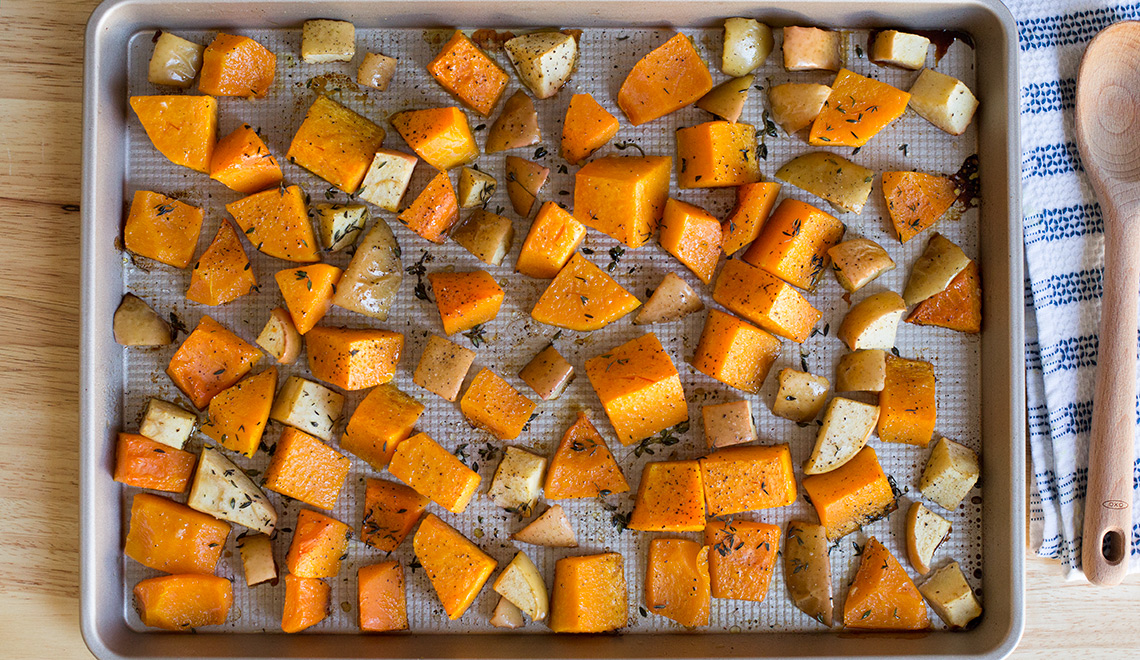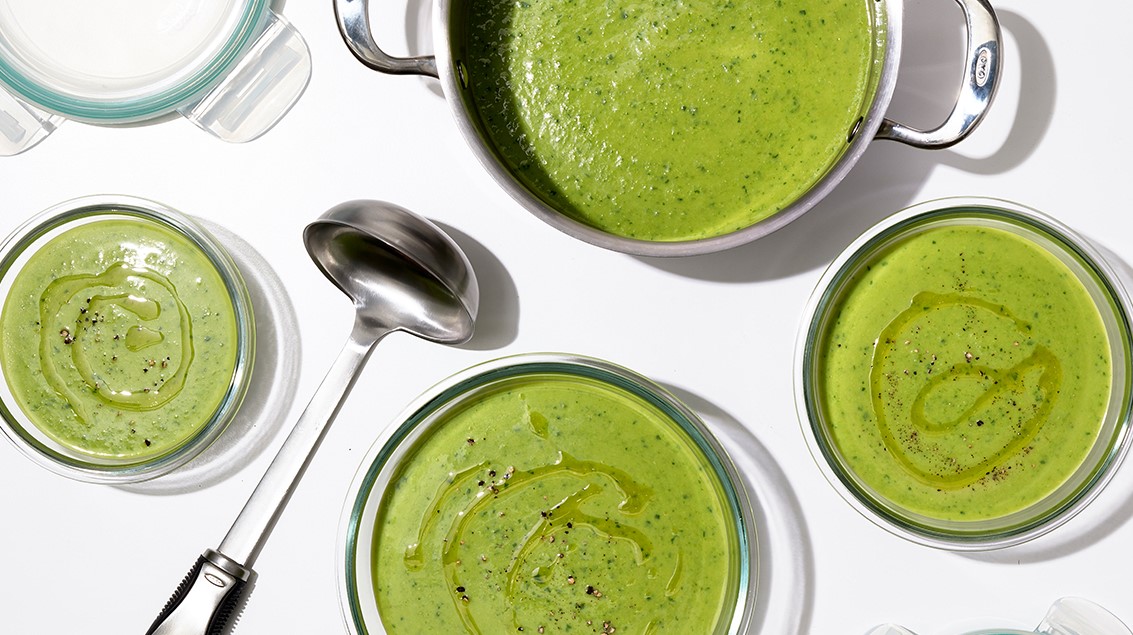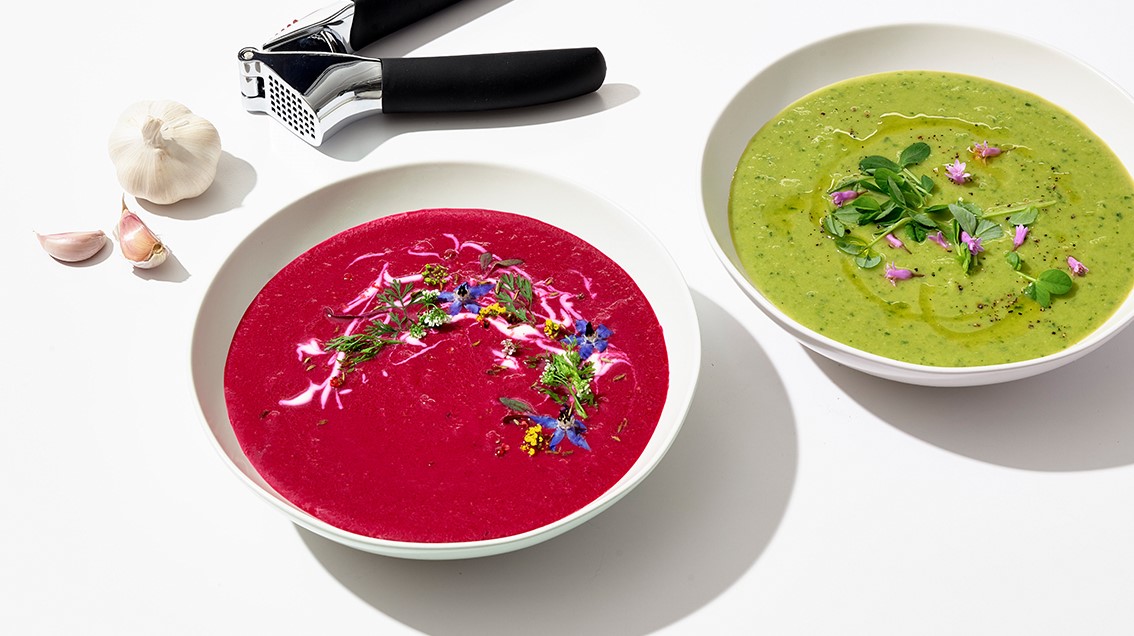
5 Tips for Making Better Pureed Soups
Posted by OXO on 28th May 2021
Pureed soups are easy to whip together on those bitter cold nights. Fill up on smooth soups with this technique.
As soon as the temperature drops, pureed soups instantly warm up your insides and bring you back to life.
All you need to do is follow these five simple tips, which involve vegetables, liquid, acid, garnishes and an stick blender.
Read on below to see how to make creamy pureed soups.
Vegetables
Dial up your oven to 200°C and roast a big batch of vegetables on a couple of pans. Roasting the vegetables softens them while adding a little bit of caramelised flavour that you don’t get from cooking on the stovetop. If you prefer not to roast, you can dice your vegetables and do a quick sauté in the pot instead.
As a general rule of thumb, vegetables that make for great soup building blocks are: brassicas (cauliflower or broccoli), squash (pumpkin, butternut squash) or root vegetables (sweet potatoes, potatoes) because they’re easy to blend after roasting. If you end up not using all the vegetables you roasted, store them away in
containers in the freezer to use in other dishes during the week.
Liquid
Adding liquid is essential to thin out the soup and ensure it doesn’t turn into the texture of thick baby food. It’s also great for adding another layer of flavour to the soup. Vegetable or chicken stock are standard, versatile liquids. Don’t have stock or broth on hand? Make a miso broth by stirring a tablespoon or two of miso paste into hot water. For a creamier soup, add heavy cream, yoghurt, or coconut milk.
Acid
If you just combine liquid with vegetables, you’ll end up with a very one-dimensional soup. To offset this, add in a dash of acidity—rice wine vinegar, apple cider vinegar, sherry wine vinegar, red wine vinegar. Lemon juice also works if you want a more citrusy flavour profile.
Garnishes and Other Add-Ins
This is where you can get creative and add texture! Chopped herbs like spring onion, basil, coriander, thyme, or fresh ginger are great for adding another flavour dimension as well as some texture. For even more texture, throw in crunchy croutons, sesame seeds, or spring onion. For an extra kick, stir in add-ins like hot sauce, curry paste, or goats cheese.
Puree Techniques
Use an stick blender to simply blend together the vegetables and liquid, add a touch of acidity and then top with garnishes. Once you get the hang of basic soup-making, you can start experimenting by adding new flavours to introduce a little more complexity.
Here are some three combinations worth trying.
Made piping hot, these will certainly cure frozen fingertips:
Butternut pumpkin, miso broth, apple cider vinegar, grated ginger, sesame seeds, and spring onion
Cauliflower, coconut milk, rice vinegar, curry paste, Thai basil
Lentils, greens, chicken broth, lemon juice, feta cheese, and coriander
Now that you’ve unlocked the key to pureed soups, check out our vegetable tools to make the whole prepping process easier.
Pureed soups are easy to whip together on those bitter cold nights. Fill up on smooth soups with this technique.
As soon as the temperature drops, pureed soups instantly warm up your insides and bring you back to life.
All you need to do is follow these five simple tips, which involve vegetables, liquid, acid, garnishes and an stick blender.
Read on below to see how to make creamy pureed soups.
Vegetables
Dial up your oven to 200°C and roast a big batch of vegetables on a couple of pans. Roasting the vegetables softens them while adding a little bit of caramelised flavour that you don’t get from cooking on the stovetop. If you prefer not to roast, you can dice your vegetables and do a quick sauté in the pot instead.
As a general rule of thumb, vegetables that make for great soup building blocks are: brassicas (cauliflower or broccoli), squash (pumpkin, butternut squash) or root vegetables (sweet potatoes, potatoes) because they’re easy to blend after roasting. If you end up not using all the vegetables you roasted, store them away in
containers in the freezer to use in other dishes during the week.
Liquid
Adding liquid is essential to thin out the soup and ensure it doesn’t turn into the texture of thick baby food. It’s also great for adding another layer of flavour to the soup. Vegetable or chicken stock are standard, versatile liquids. Don’t have stock or broth on hand? Make a miso broth by stirring a tablespoon or two of miso paste into hot water. For a creamier soup, add heavy cream, yoghurt, or coconut milk.
Acid
If you just combine liquid with vegetables, you’ll end up with a very one-dimensional soup. To offset this, add in a dash of acidity—rice wine vinegar, apple cider vinegar, sherry wine vinegar, red wine vinegar. Lemon juice also works if you want a more citrusy flavour profile.
Garnishes and Other Add-Ins
This is where you can get creative and add texture! Chopped herbs like spring onion, basil, coriander, thyme, or fresh ginger are great for adding another flavour dimension as well as some texture. For even more texture, throw in crunchy croutons, sesame seeds, or spring onion. For an extra kick, stir in add-ins like hot sauce, curry paste, or goats cheese.
Puree Techniques
Use an stick blender to simply blend together the vegetables and liquid, add a touch of acidity and then top with garnishes. Once you get the hang of basic soup-making, you can start experimenting by adding new flavours to introduce a little more complexity.
Here are some three combinations worth trying.
Made piping hot, these will certainly cure frozen fingertips:
Butternut pumpkin, miso broth, apple cider vinegar, grated ginger, sesame seeds, and spring onion
Cauliflower, coconut milk, rice vinegar, curry paste, Thai basil
Lentils, greens, chicken broth, lemon juice, feta cheese, and coriander
Now that you’ve unlocked the key to pureed soups, check out our vegetable tools to make the whole prepping process easier.


